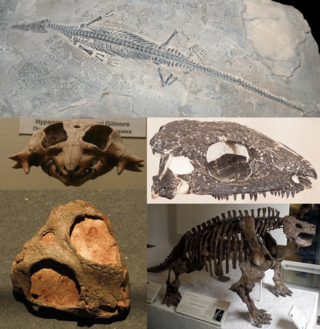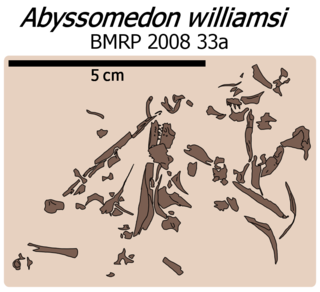
Varanops is an extinct genus of Early Permian varanopid known from Texas and Oklahoma of the United States. It was first named by Samuel Wendell Williston in 1911 as a second species of Varanosaurus, Varanosaurus brevirostris. In 1914, Samuel W. Williston reassigned it to its own genus and the type species is Varanops brevirostris.

Parareptilia ("near-reptiles") is a subclass or clade of basal sauropsids/reptiles, typically considered the sister taxon to Eureptilia. Parareptiles first arose near the end of the Carboniferous period and achieved their highest diversity during the Permian period. Several ecological innovations were first accomplished by parareptiles among reptiles. These include the first reptiles to return to marine ecosystems (mesosaurs), the first bipedal reptiles, the first reptiles with advanced hearing systems, and the first large herbivorous reptiles. The only parareptiles to survive into the Triassic period were the procolophonoids, a group of small generalists, omnivores, and herbivores. The largest family of procolophonoids, the procolophonids, rediversified in the Triassic, but subsequently declined and became extinct by the end of the period.

Bolosaurus is an extinct genus of bolosaurid ankyramorph parareptile from the Cisuralian epoch of North Asia and North America.

Captorhinus is an extinct genus of captorhinid reptiles that lived during the Permian period. Its remains are known from North America and possibly South America.

Colobomycter is an extinct genus of lanthanosuchoid parareptile known from the Early Permian of Oklahoma.
Llistrofus is an extinct genus of early Permian microsaur within the family Hapsidopareiidae that is known from Oklahoma.
Sillerpeton is an extinct genus of aïstopod tetrapodomorphs within the family Phlegethontiidae. It contains a single species, Sillerpeton permianum, which is based on braincases and vertebrae from the Early Permian Richards Spur locality of Oklahoma.

Acleistorhinidae is an extinct family of Late Carboniferous and Early Permian-aged parareptiles. Acleistorhinids are most diverse from the Richards Spur locality of the Early Permian of Oklahoma. Richards Spur acleistorhinids include Acleistorhinus, Colobomycter, and possibly Delorhynchus and Feeserpeton. Other taxa include Carbonodraco from the Late Carboniferous of Ohio and Karutia from the Early Permian of Brazil. Acleistorhinidae is commonly considered a subgroup of lanthanosuchoids, related to taxa such as Chalcosaurus, Lanthaniscus and Lanthanosuchus. However, a re-examination of parareptile phylogeny conducted by Cisneros et al. (2021) argued that lanthanosuchids were not closely related to acleistorhinids. The phylogenetic analysis conducted by these authors recovered acleistorhinids as the sister group of the clade Procolophonia, while lanthanosuchids were recovered within the procolophonian subgroup Pareiasauromorpha.

Acleistorhinus (ah-kles-toe-RYE-nuss) is an extinct genus of parareptile known from the Early Permian of Oklahoma. It is notable for being the earliest known anapsid reptile yet discovered. The morphology of the lower temporal fenestra of the skull of Acleistorhinus bears a superficial resemblance to that seen in early synapsids, a result of convergent evolution. Only a single species, A. pteroticus, is known, and it is classified in the Family Acleistorhinidae, along with Colobomycter.
Pasawioops is an extinct genus of early Permian dissorophoid temnospondyl within the clade Amphibamiformes.

Microleter is an extinct genus of basal procolophonomorph parareptiles which lived in Oklahoma during the Early Permian period. The type and only known species is Microleter mckinzieorum. Microleter is one of several parareptile taxa described from the Richards Spur fissure fills, and can be characterized from its high tooth count, lacrimal/narial contact, short postfrontal, and slit-like temporal emargination edged by the postorbital, jugal, squamosal, and quadratojugal. Contrary to Australothyris, which had a similar phylogenetic position as a basal procolophonomorph, Microleter suggests that early parareptile evolution occurred in Laurasia and that multiple lineages developed openings or emarginations in the temporal region.
Australothyris is an extinct genus of basal procolophonomorph parareptile known from the Middle Permian of Tapinocephalus Assemblage Zone, South Africa. The type and only known species is Australothyris smithi. As the most basal member of Procolophonomorpha, Australothyris helped to contextualize the origin of this major parareptile subgroup. It has been used to support the hypotheses that procolophonomorphs originated in Gondwana and ancestrally possess temporal fenestrae, due to its large and fully enclosed temporal fenestra and South African heritage. It also possessed several unique features, including a high tooth number, long postfrontal, small interpterygoid vacuity, and a specialized interaction between the stapes and quadrate.

Orovenator is an extinct genus of diapsid from Lower Permian deposits of Oklahoma, United States. It is known from two partial skulls from the Richards Spur locality in Oklahoma. The holotype OMNH 74606 consists of a partial skull preserving snout and mandible, and the referred specimen, OMNH 74607, a partial skull preserving the skull roof, vertebrae and palatal elements. It was first named by Robert R. Reisz, Sean P. Modesto and Diane M. Scott in 2011 and the type species is Orovenator mayorum. The generic name means "mountain", oro, in Greek in reference to the Richards Spur locality, which was mountainous during the Permian period and "hunter", venator, in Latin. The specific name honours Bill and Julie May. Orovenator is the oldest and most basal neodiapsid to date.
Baeotherates is an extinct genus of Early Permian captorhinid reptile known from Oklahoma, United States.

Lanthanosuchoidea is an extinct superfamily of ankyramorph parareptiles from the middle Pennsylvanian to the middle Guadalupian epoch of Europe, North America and Asia. It was named by the Russian paleontologist Ivachnenko in 1980, and it contains two families Acleistorhinidae and Lanthanosuchidae.
Nyctiphruretidae is an extinct family of hallucicranian parareptiles known from the late Early to the late Middle Permian of European Russia and south-central United States.

Feeserpeton is an extinct genus of parareptile from the Early Permian of Richard's Spur, Oklahoma. It is known from a single species, Feeserpeton oklahomensis, which was named in 2012 on the basis of a nearly complete skull. Feeserpeton is a member of the clade Lanthanosuchoidea and is one of the earliest parareptiles.

Abyssomedon is an extinct genus of a nyctiphruretid parareptile known from Early Permian fissure fills at Richards Spur in Comanche County, Oklahoma, south-central United States. It contains a single species, Abyssomedon williamsi, which represents oldest known nyctiphruretid species and the first to be discovered in North America.

Richards Spur is a Permian fossil locality located at the Dolese Brothers Limestone Quarry north of Lawton, Oklahoma. The locality preserves clay and mudstone fissure fills of a karst system eroded out of Ordovician limestone and dolomite, with the infilling dating to the Artinskian stage of the early Permian (Cisuralian), around 289 to 286 million years ago. Fossils of terrestrial animals are abundant and well-preserved, representing one of the most diverse Paleozoic tetrapod communities known. A common historical name for the site is Fort Sill, in reference to the nearby military base. Fossils were first reported at the quarry by workers in 1932, spurring a wave of collecting by local and international geologists. Early taxa of interest included the abundant reptile Captorhinus and microsaurs such as Cardiocephalus and Euryodus. Later notable discoveries include Doleserpeton, the most diverse assortment of parareptiles in the Early Permian, and the rare early diapsid Orovenator.

Carbonodraco is an extinct genus of acleistorhinid parareptile known from the Late Carboniferous of Ohio. It contains a single species, Carbonodraco lundi. It was closely related to Colobomycter, a parareptile from the early Permian of Oklahoma. Carbonodraco is the oldest known parareptile, and is slightly older than Erpetonyx, the previously oldest known parareptile. Specimens of Carbonodraco are limited to skull and jaw fragments found at the Ohio Diamond Coal mine in Linton, Ohio. These include the holotype specimen and two referred specimens. Several of the Carbonodraco specimens were previously referred to the Carboniferous eureptile Cephalerpeton by Reisz & Baird (1983). They were recognized as a distinct species in a 2019 study by Mann et al.




















